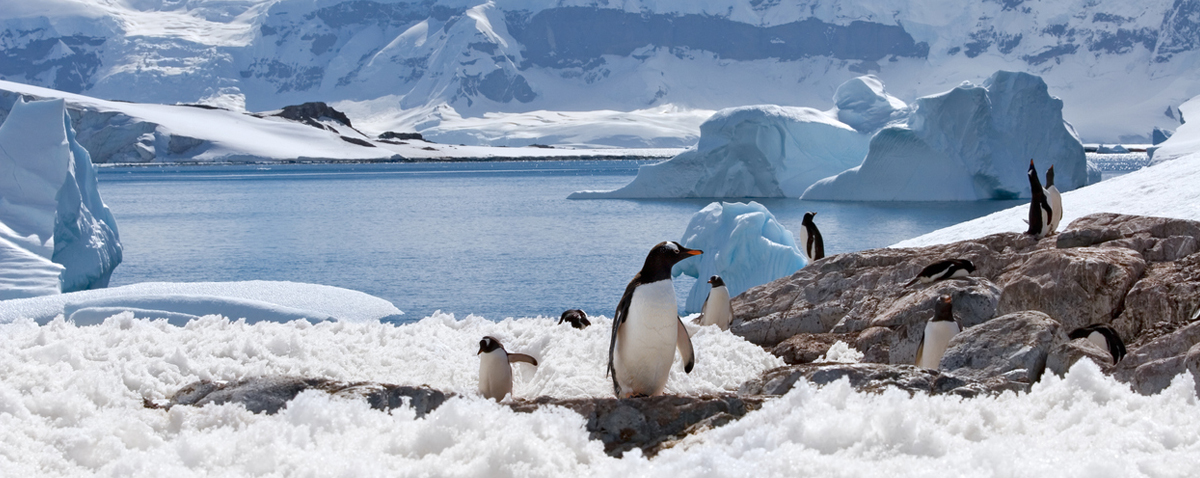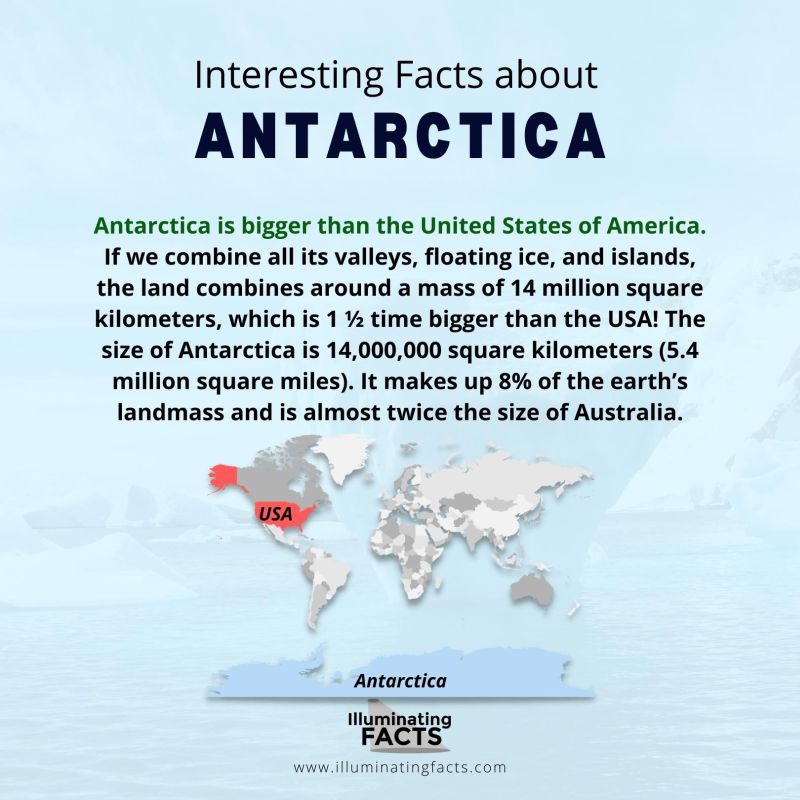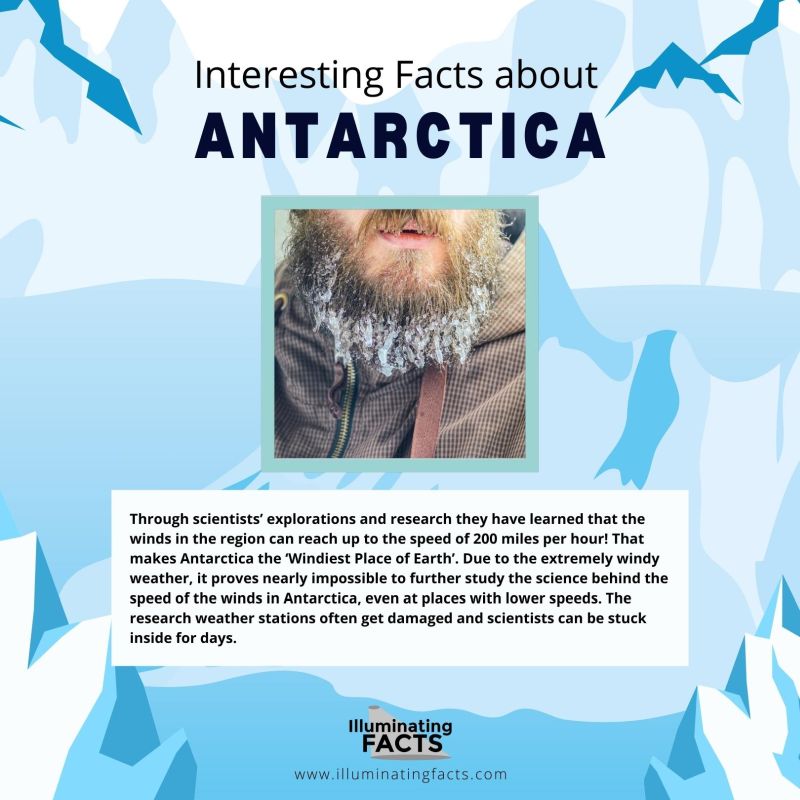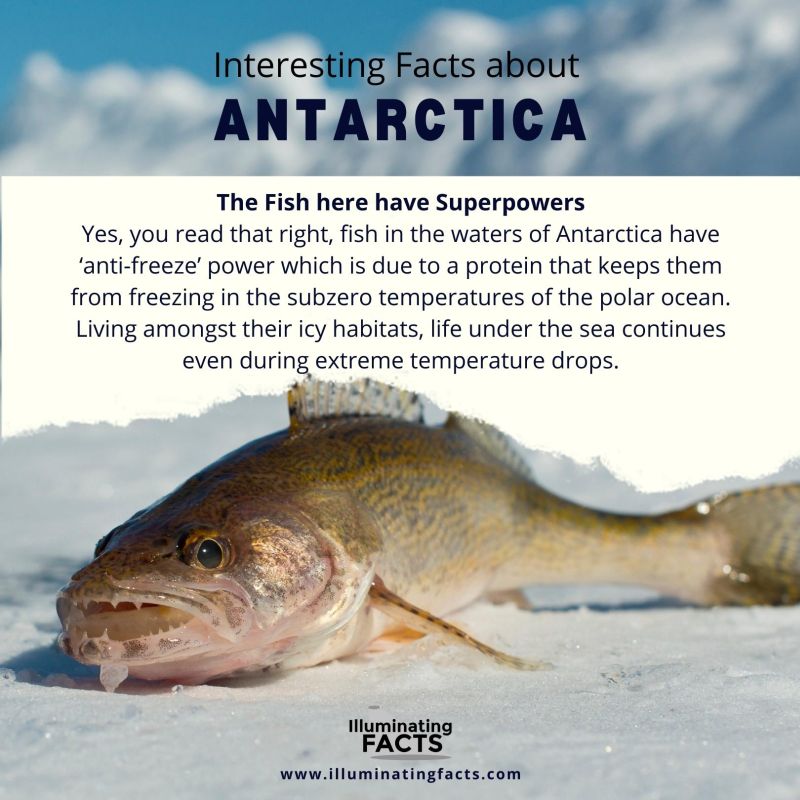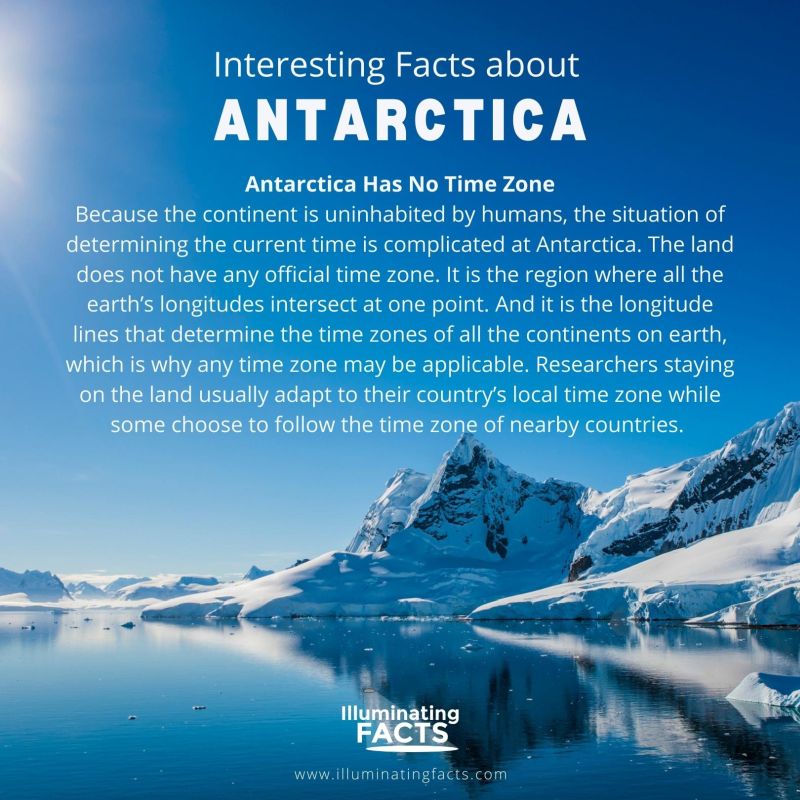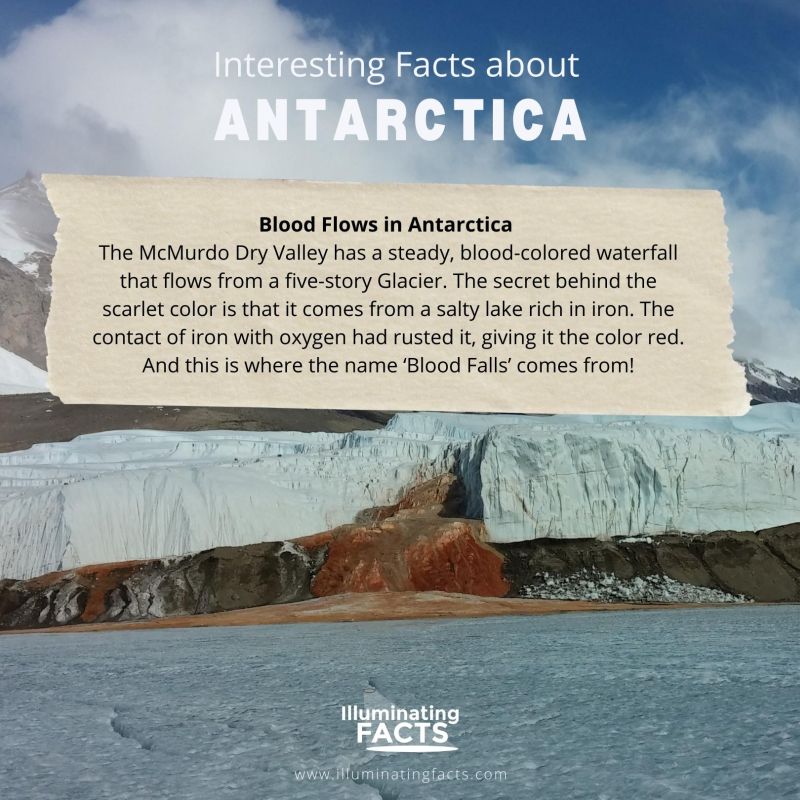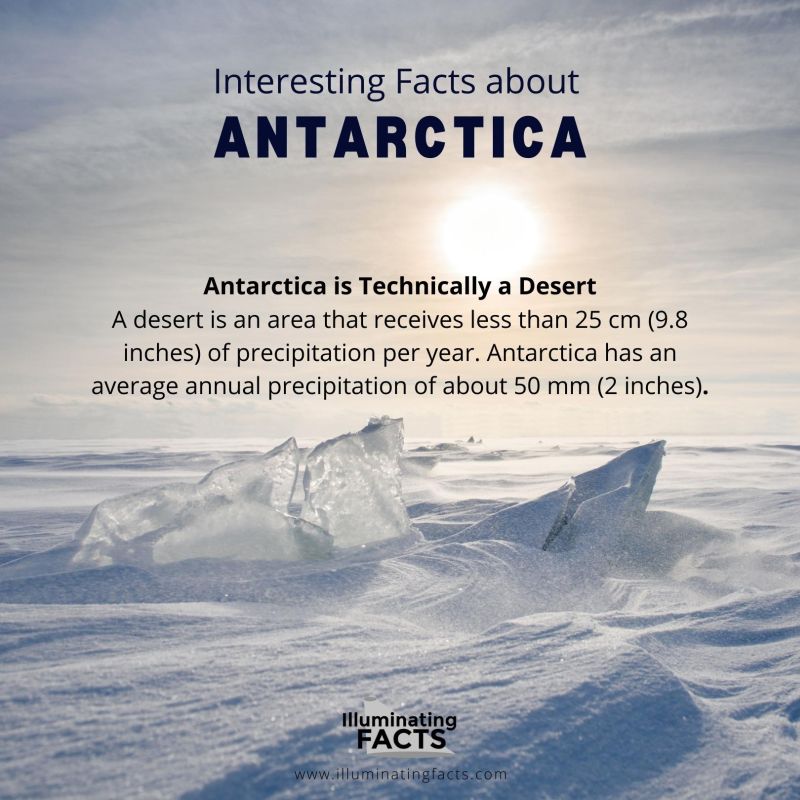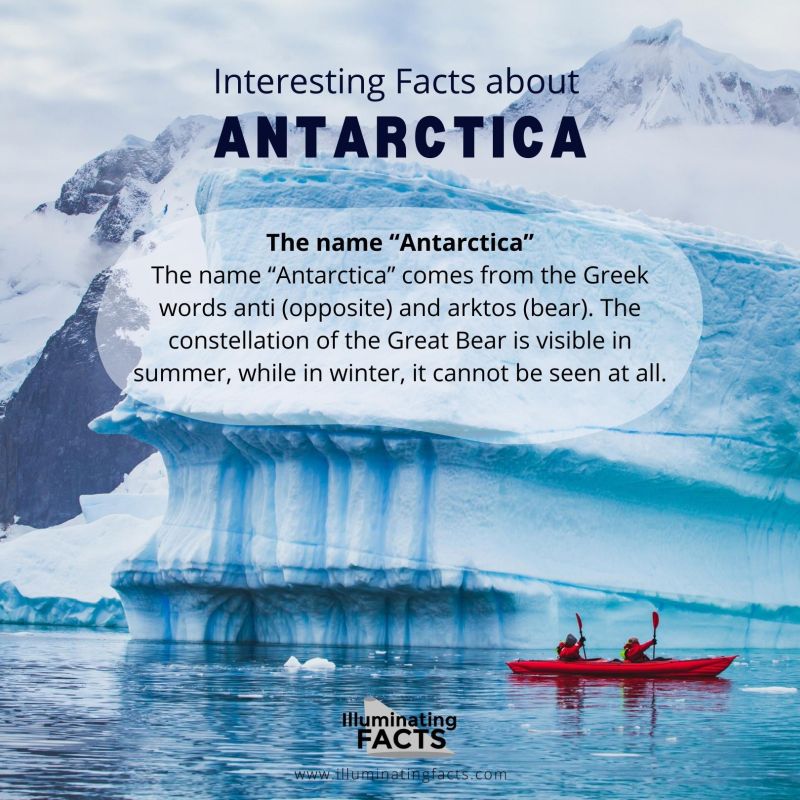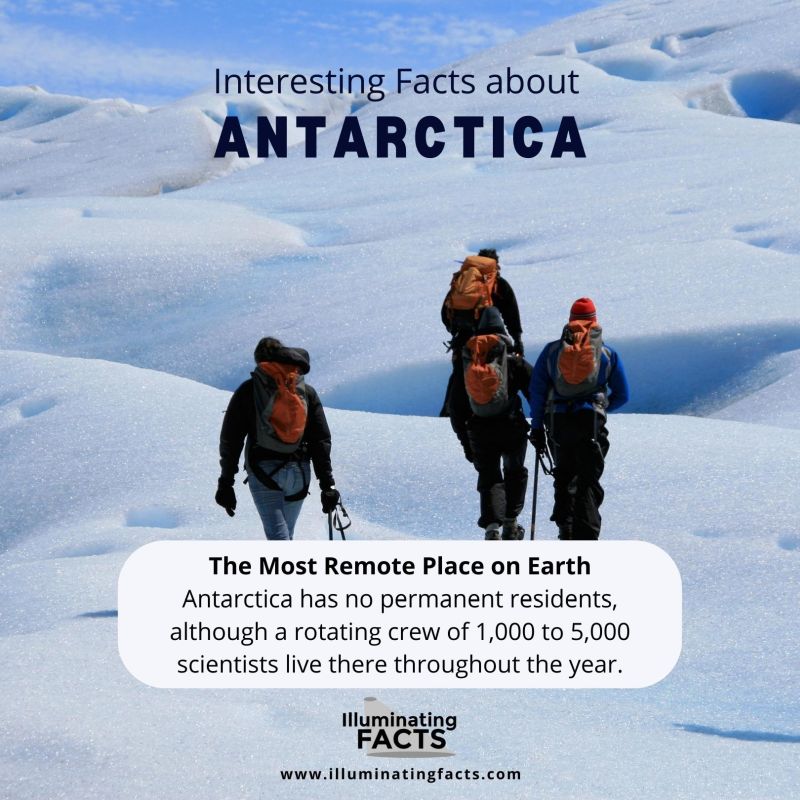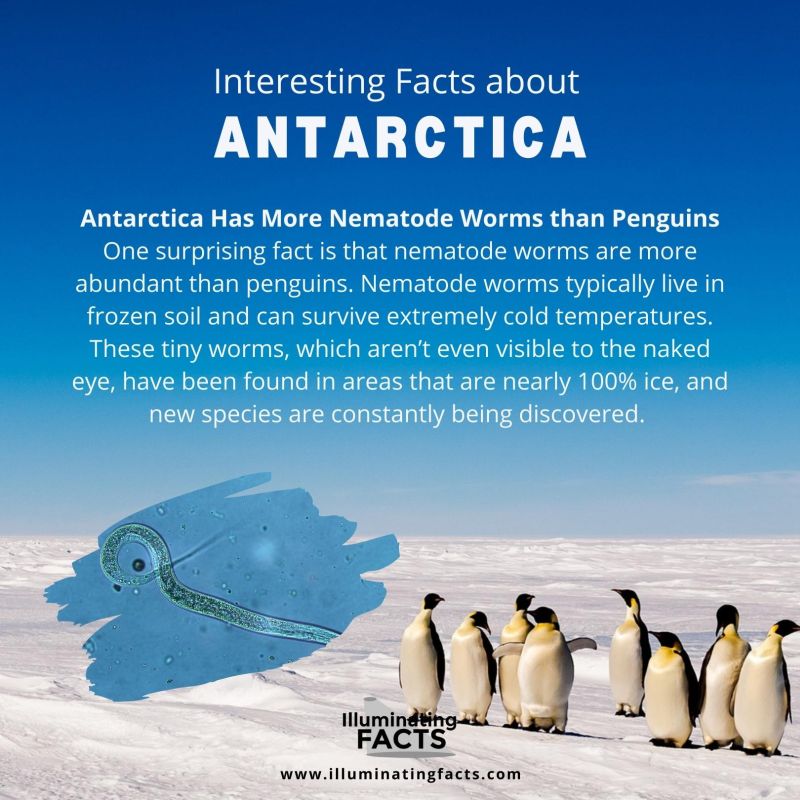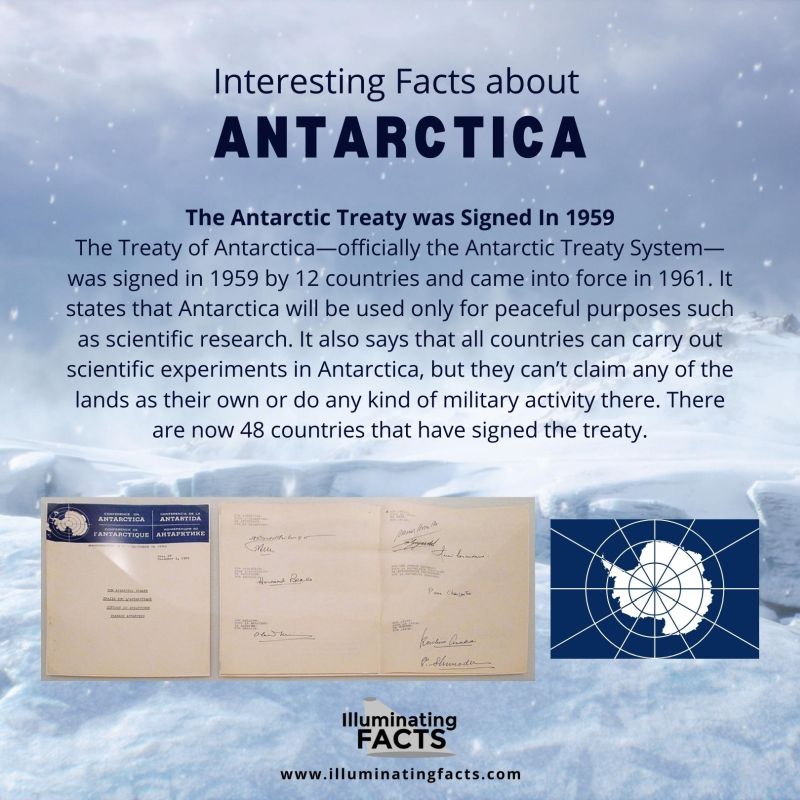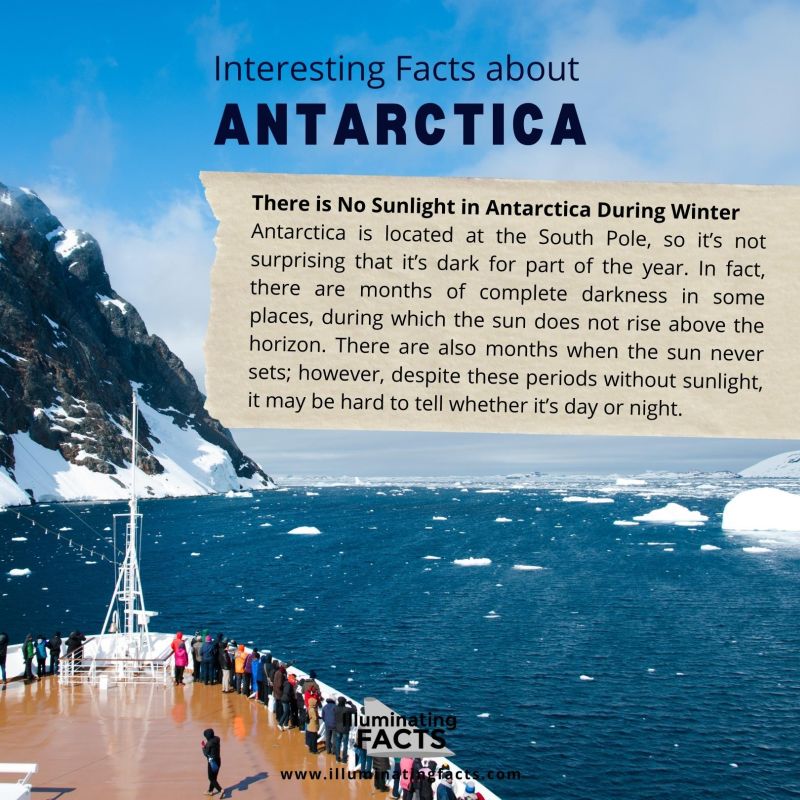Antarctica is the land of extremes, and it contains extreme dry cold deserts, such as the Antarctic plateau, with winter temperature hovering around -50°C . Antarctica contains huge glaciers and floating sea ice covering over5.5 million square miles. It hosts a number of species, including penguins, seals, whales, seabirds, and flying birds that hunt the seals and penguins. It has proved to be a masterpiece of nature with lots of variety and complexity.
When discussing interesting facts about Antarctica, most people automatically think of its cold temperature and the purity of ice. The weather conditions in this continent are extremely harsh, and even the plant life has to adapt to its surroundings. Below is a list of fun facts about Antarctica that you may not have heard before, so make sure you take a moment to read it!
1. Antarctica is the Coldest Place on Earth!
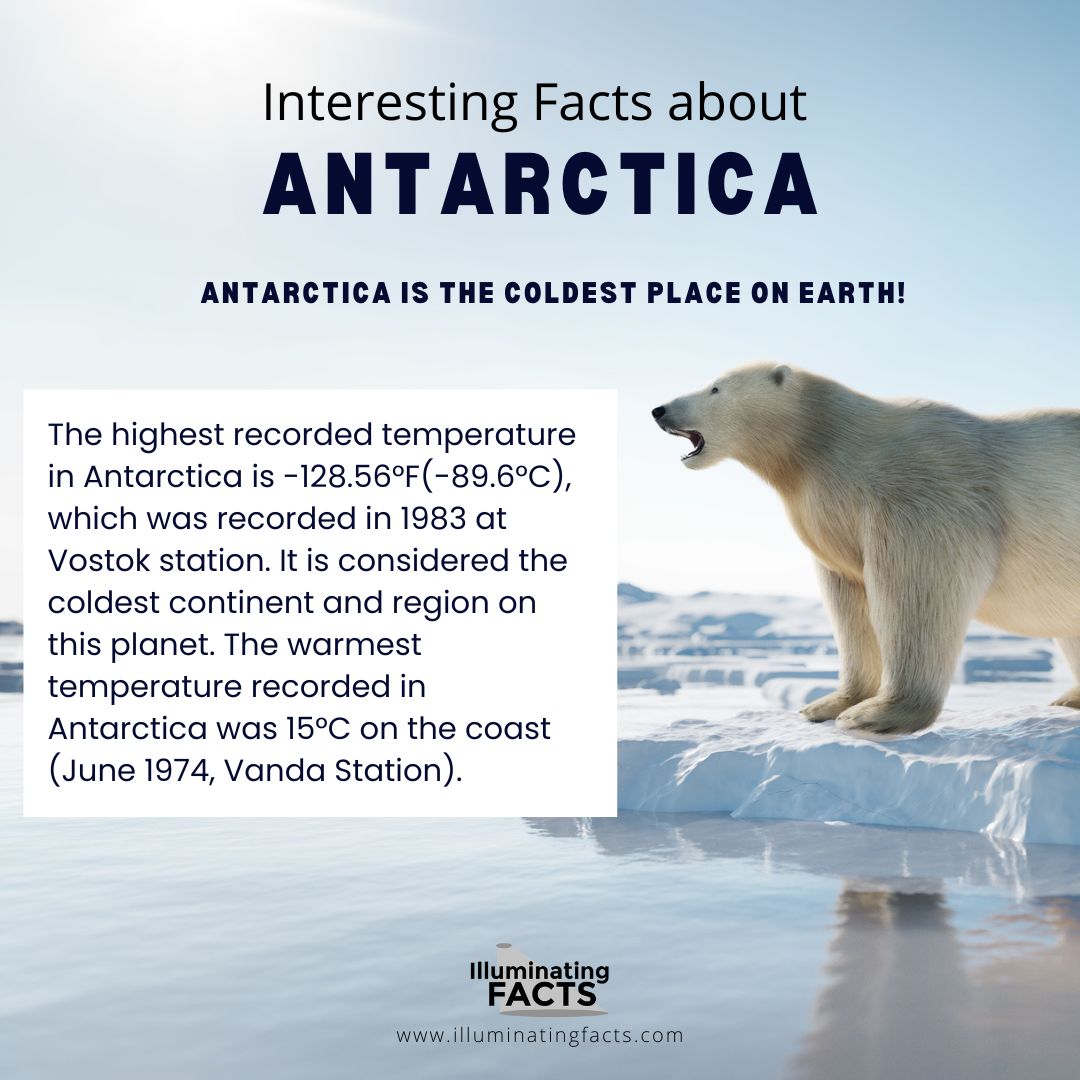
The highest recorded temperature in Antarctica is -128.56°F(-89.6°C), which was recorded in 1983 at Vostok station. It is considered the coldest continent and region on this planet. The warmest temperature recorded in Antarctica was 15°C on the coast (June 1974, Vanda Station). [1]
2. Antarctica Holds 90% of the Planet’s Ice Volume
With the amount of ice present in Antarctica, it’s the world’s biggest freshwater reserve. There’s no surprise that if it all melted, it could raise the earth’s water levels to an estimated 200 feet!
The valleys and ranges in Antarctica are measured up by the ice sheet covering the desert, being 5.5 million square miles. The thickest part of the ice house may even be compared to half the altitude of Mount Everest. The mass of the ice sheet, if melted, is thick enough to submerge the whole dry land of Antarctica. [2]
3. The Driest Place on Earth
Even though the region has the biggest mass of ice volume, the land is the driest continent on the whole of the planet. The reason is low moisture and humidity levels in the area; snow is unable to even form, which leaves the rusty valleys of Antarctica dry and as a dusty land of dirt. Dry Valleys of Antarctica probably have not seen any rain for millions of years and are considered to be the driest places on earth. Someone there would lose water there just by breathing and the dryness will slowly keep dehydrating until all water is lost to the air.
4. Home to Wildlife
Antarctica is better known for the Emperor Penguins that breed there, but it has a rich diversity of wildlife. There are Blue Whales, Orcas, Seals, and Sea Birds that reside in the southern region surrounding Antarctica. The winters are low on the sightings of the sea animals, but their summertime visits near the land are unlike anywhere else on the planet. [3]
5. Discovery of a Lifetime in Antarctica
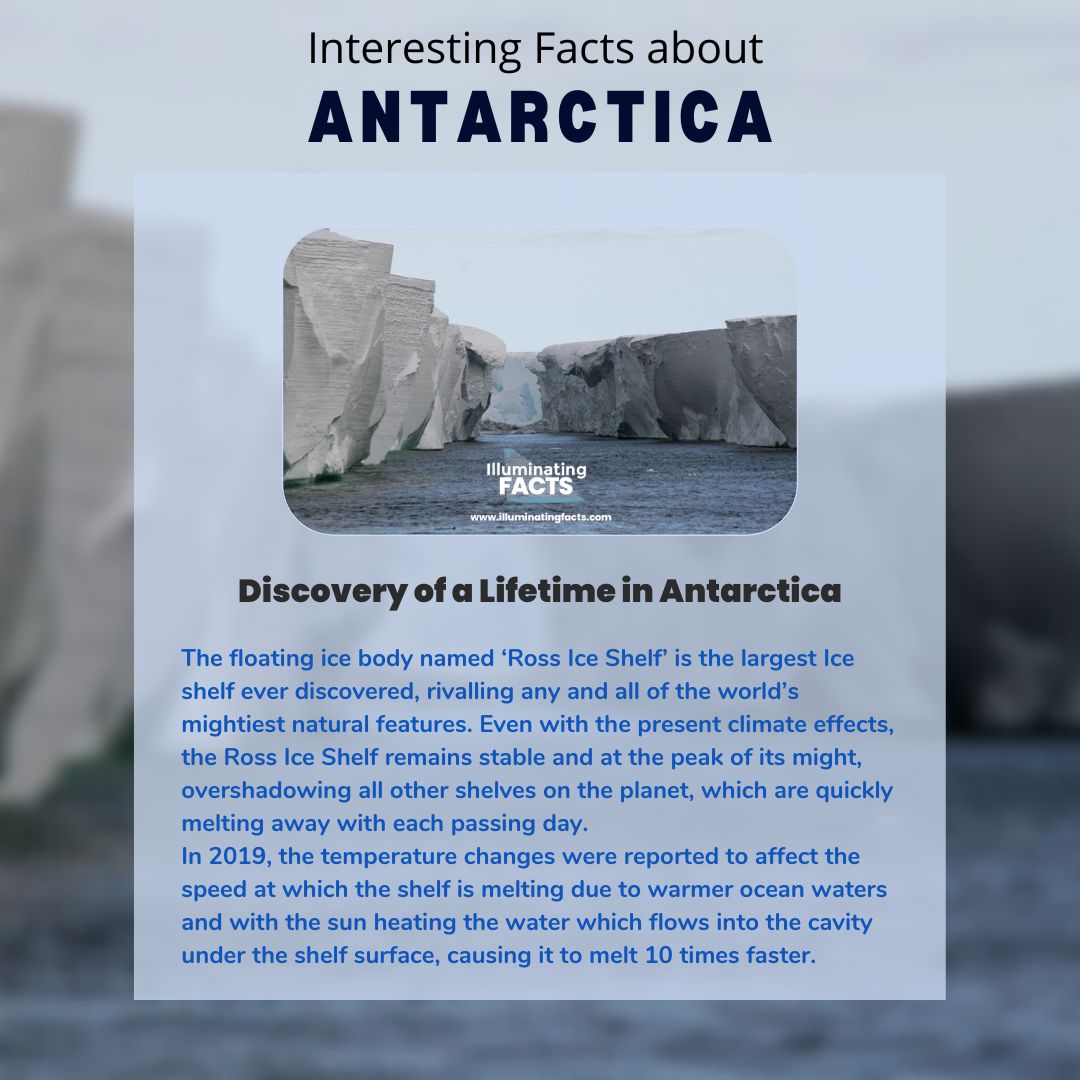
The floating ice body named ‘Ross Ice Shelf’ is the largest Ice shelf ever discovered, rivalling any and all of the world’s mightiest natural features. Even with the present climate effects, the Ross Ice Shelf remains stable and at the peak of its might, overshadowing all other shelves on the planet, which are quickly melting away with each passing day.
In 2019, the temperature changes were reported to affect the speed at which the shelf is melting due to warmer ocean waters and with the sun heating the water which flows into the cavity under the shelf surface, causing it to melt 10 times faster. [4]
6. Antarctica is bigger than the United States of America
If we combine all its valleys, floating ice, and islands, the land joins to around a mass of 14 million square kilometers, which is 1 ½ time bigger than the USA! [5]
The size of Antarctica is 14,000,000 square kilometers (5.4 million square miles). which is more than twice the size of Australia.
7. Talk about having a Bad Hair Day at the Arctic
The scientists’ explorations and research led them to find out that the winds in the region reach up to the speed of 200 miles per hour! Naming Antarctica the ‘Windiest Place of Earth.’ Due to the extremely windy weather, it proves nearly impossible to further study the science behind the speed of winds in Antarctica, even at places with lesser speeds.
The weather stations set to research the matter have been recorded to get damaged while keeping the scientists inside as prisoners for days. [5]
8. The Fish here have Superpowers
Yes, you read it right, the fish in the waters of Antarctica have the ‘anti-freeze’ power or rather a protein that keeps them from freezing in the subzero temperatures of the polar ocean. Living amongst their icy habitats, life under the sea continues even during extreme temperature drops. [6]
9. There are Hidden Mysteries under the Ice
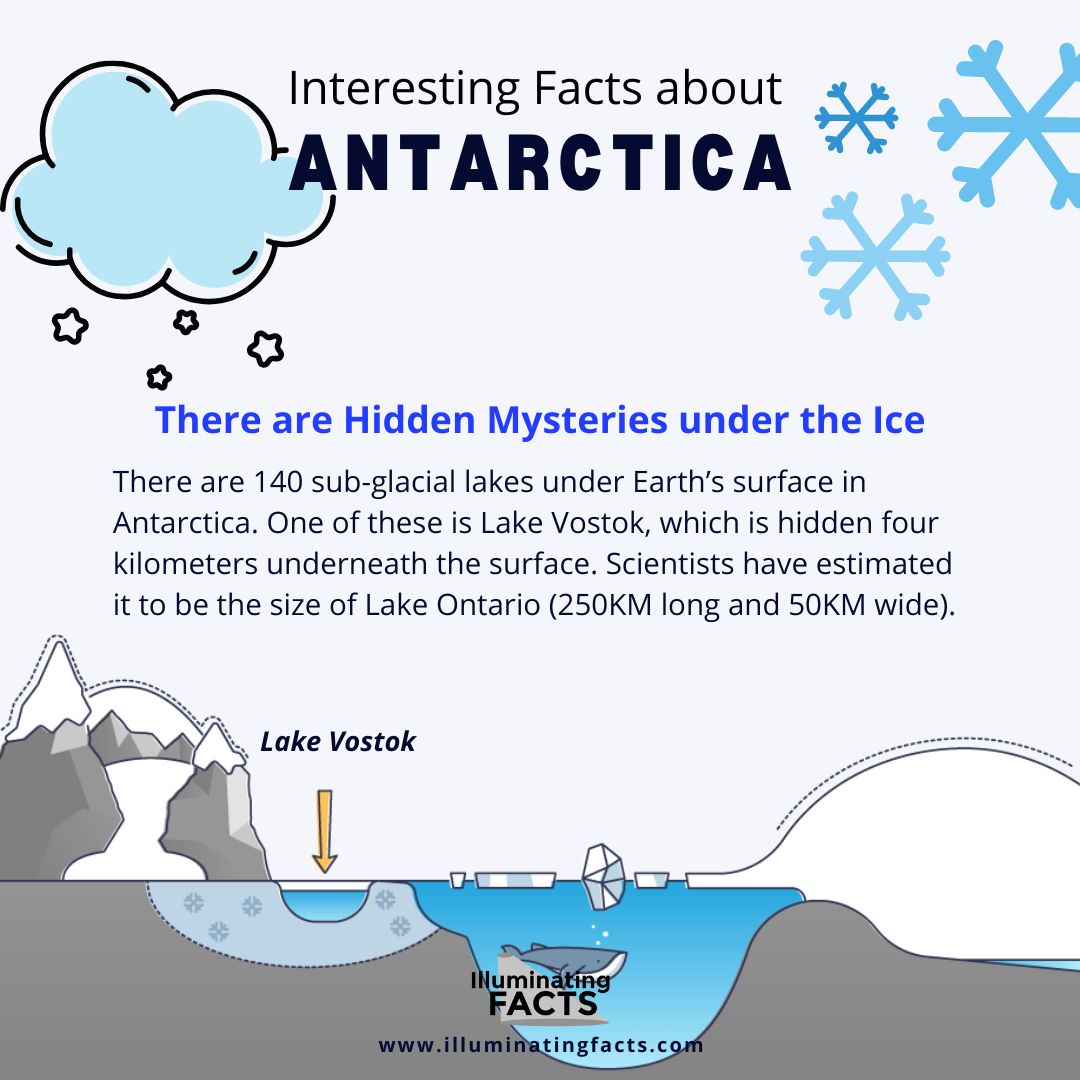
There are 140 sub-glacial lakes under Earth’s surface in Antarctica. One of these is Lake Vostok, which is hidden four kilometers underneath the surface. Scientists have estimated it to be the size of Lake Ontario (250KM long and 50KM wide).
10. Antarctica Has No Time Zone
Because the continent is uninhabited by humans, the situation of the time is complicated at Antarctica. The land has hence not been given any official time zone. It is the region where all the earth’s longitudes intersect at one point. And it is the longitude lines that determine the time zones of all the continents on earth, which is why any time zone may be applicable there.
The researchers staying on the land usually adapt to their country’s local time zone, while the rest choose to follow the time zone of countries nearby.
11. Blood Flows in Antarctica 
The McMurdo Dry Valley has a steady, blood-colored waterfall that flows from a five-story Glacier. The secret behind the scarlet color is that it comes from a salty lake rich in iron. The contact of iron with oxygen had rusted it, giving it the color red. And this is where the name ‘Blood Falls’ comes from! [7]
12. Antarctica is Technically a Desert
A desert is an area that receives less than 25 cm (9.8 inches) of precipitation per year. Antarctica has an average annual precipitation of about 50 mm (2 inches). [8]
13. The name “Antarctica”.
The name “Antarctica” comes from the Greek words anti (opposite) and arktos (bear). The constellation of the Great Bear is visible in summer, while in winter, it cannot be seen at all. [9]
14. The Most Remote Place on Earth
Antarctica has no permanent residents, although a rotating crew of 1,000 to 5,000 scientists live there throughout the year.
15. Antarctica Has More Nematode Worms than Penguins
One surprising fact is that nematode worms are more abundant than penguins. Nematode worms typically live in frozen soil and can survive extremely cold temperatures.
These tiny worms, which aren’t even visible to the naked eye, have been found in areas that are nearly 100% ice, and new species are constantly being discovered. Scientists also believe that these nematodes, which can survive freezing temperatures by entering a state similar to hibernation, could hold clues to how humans might be able to survive on other planets. [10]
16. Research Stations in Antarctica
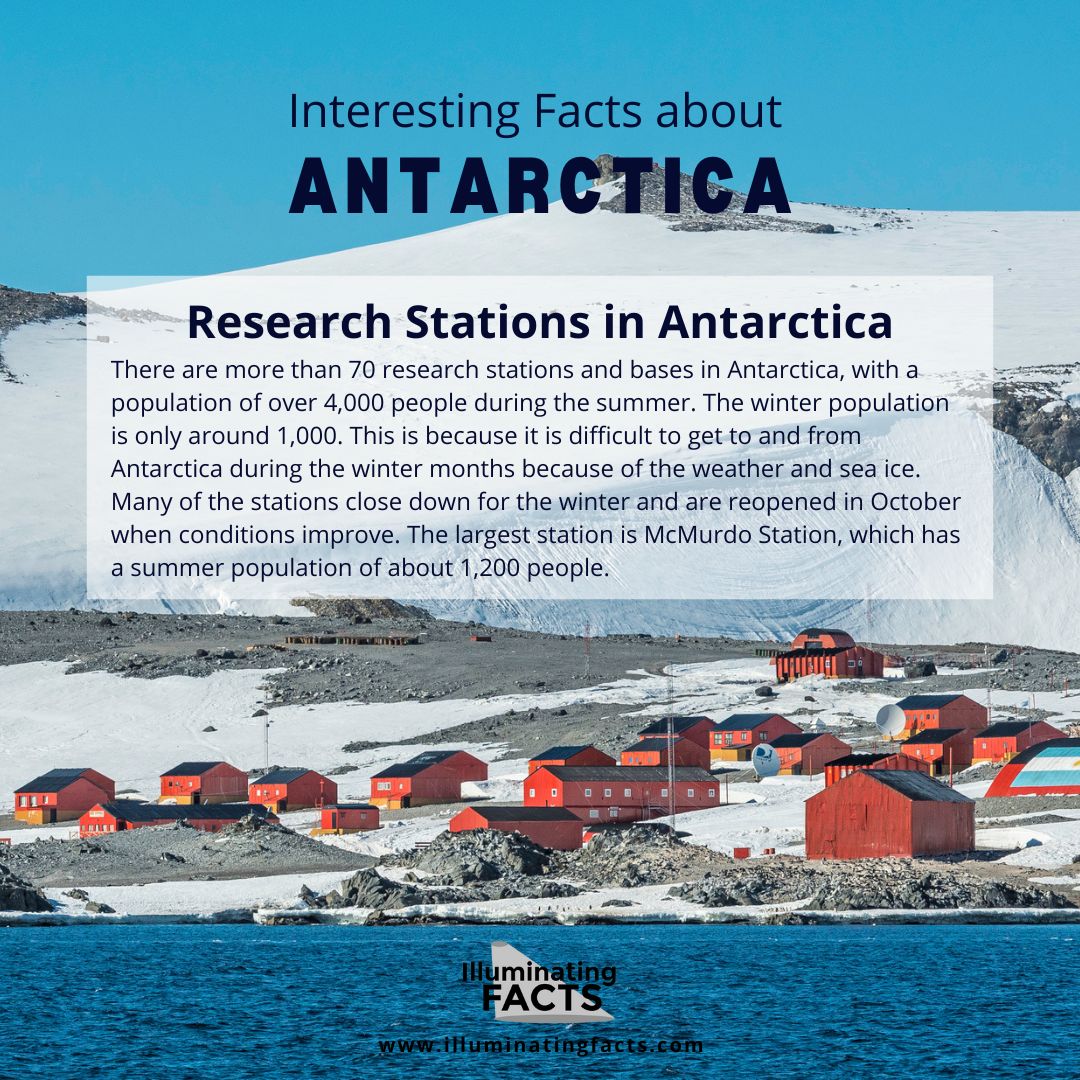
There are more than 70 research stations and bases in Antarctica, with a population of over 4,000 people during the summer. The winter population is only around 1,000. This is because it is difficult to get to and from Antarctica during the winter months because of the weather and sea ice.
Many of the stations close down for the winter and are reopened in October when conditions improve. The largest station is McMurdo Station, which has a summer population of about 1,200 people.
17. The Antarctic Treaty was Signed In 1959
The Treaty of Antarctica—officially the Antarctic Treaty System—was signed in 1959 by 12 countries and came into force in 1961. It states that Antarctica will be used only for peaceful purposes such as scientific research. It also says that all countries can carry out scientific experiments in Antarctica, but they can’t claim any of the lands as their own or do any kind of military activity there. There are now 48 countries that have signed the treaty. [11]
18. There Are No Polar Bears in Antarctica

There are no polar bears in Antarctica, only penguins. While Antarctica is home to 8 species of penguins, there are no polar bears anywhere on the continent. The closest polar bears can be found are at the North Pole.
19. Antarctica is Home to Two Active Volcanoes

There are two active volcanoes in Antarctica. The highest is the Mount Sidley followed by Mount Erebus, which is the southern-most active volcano and located just 25 miles from the largest research station i.e. McMurdo Station. Mount Erebus has been active since more than a million years and is also the site where an Air New Zealand plane crashed in 1979.
The constant eruption of Erebus has created a beautiful lava lake, which can be accessed on many helicopter tours around Antarctica. The volcano has been continually active since 1972, with minor activity occurring for the previous 60 years.
20. There is no Direct Sunlight in Antarctica during winters
Antarctica is located at the South Pole, so it’s not surprising that it’s dark for part of the year. In fact, there are months of complete darkness in some places, during which the sun does not rise above the horizon. There are also months when the sun never sets; however, despite these periods without sunlight, it may be hard to tell whether it’s day or night.
This is because, in Antarctica, night and day are both very dark—the sun doesn’t really get very high in the sky. Even when it is up, its light is limited by the thick cloud cover (and Antarctic clouds are always low). As a result, even during daylight hours, you may need to turn on the lights in order to see what you’re doing.
Conclusion
Antarctica is an amazing continent. You should definitely put this place on your bucket list if you have never been there. There are many interesting facts about Antarctica that make it a special and unique place. It’s a very intriguing continent in the world, with a fascinating history and geography. We hope this post was interesting and you learned something new about this amazing continent Antarctica.
References
- How cold is the Antarctic?(2017, September 26). NIWA. https://niwa.co.nz/education-and-training/schools/resources/climate/antarctic
- The Planet D. (2021, June 14). Fascinating facts about Antarctica that will surprise you. The Planet D: Adventure Travel Blog. https://theplanetd.com/facts-about-antarctica/
- Antarctica wildlife. (n.d.). Home. https://www.antarcticaguide.com/antarctica-wildlife-2
- Signs of faster melting in world’s largest ice shelf. (2019, April 30). BBC News. https://www.bbc.com/news/science-environment-48107497
- Thompson, A. (2022, January 19). 50 amazing facts about Antarctica. livescience.com. https://www.livescience.com/43881-amazing-antarctica-facts.html
- Fish antifreeze proteins. (n.d.). NSF – National Science Foundation. https://www.nsf.gov/pubs/1996/nstc96rp/sb3.htm
- Dry valleys Antarctica – McMurdo, Victoria land. (n.d.). Cool Antarctica, pictures of Antarctica, facts and travel guide. https://www.coolantarctica.com/Antarctica%20fact%20file/antarctica%20environment/dry-valleys-blood-falls-don-juan-pond.php
- Antarctica – Climate. (n.d.). Encyclopedia Britannica. https://www.britannica.com/place/Antarctica/Climate
- Victor, R. K. (2018, April 24). What are the origins of the names Arctic and Antarctica?https://www.worldatlas.com/articles/what-are-the-origins-of-the-names-arctic-and-antarctica.html
- Mustain, A. (2011, December 21). Weird wildlife: The real animals of Antarctica. livescience.com. https://www.livescience.com/30991-weird-wildlife-real-animals-antarctica-penguins.html
- Antarctic Treaty. (n.d.). NTI.org. https://www.nti.org/education-center/treaties-and-regimes/antarctic-treaty/

